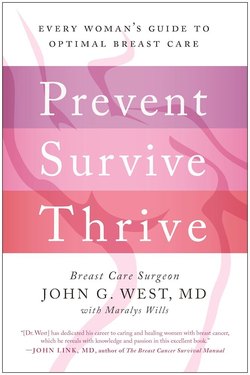Читать книгу Prevent, Survive, Thrive - John G. West - Страница 10
На сайте Литреса книга снята с продажи.
ОглавлениеCHAPTER ONE
The Controversies That Drive This Book
THE QUESTION of what constitutes optimal breast care—noted briefly in the Introduction—is not just an idle subject that is open for debate; it is now one of the most contentious issues in all of medicine.
Despite incredible progress everywhere in diagnosing and treating breast cancer, guidelines for optimal breast care today are brimming with contradictions and misleading statements. There is a growing trend to cut back on early detection efforts, based partly on flawed scientific studies, but also, regrettably, on cost. While it’s true that medical costs are spiraling out of control, any procedural change that contributes to giving cancer a greater foothold will ultimately be more expensive for everyone.
Among the biggest controversies are the following:
Screening Mammography
Clearly the most outrageous controversy I’ve witnessed was promoted by the doctor who proclaimed on Fox News that mammograms can do more harm than good and stated that one in five cancers will disappear without treatment. The reasoning behind his fallacious statement and the proof of its nonsense will be demonstrated in chapters fifteen and sixteen.
Yet other controversies have made mammograms the subject of dangerous confusion. Traditionally, women have been told that they need to begin mammograms at age forty and continue yearly.
Now a government task force, the USPSTF (United States Preventive Services Task Force), offers new, reduced-mammogram guidelines that contradict reliable, proven standards (see chapter sixteen). The USPSTF recommends that mammogram screening start at age fifty, that it be repeated only every other year, and that it be discontinued after age seventy-four—even though none of the research has suggested that routine screening be discontinued at any age as long as a woman is in good health. None of the so-called “experts” on the USPSTF were physicians whose specialty was breast care.
Breast Density
For women whose mammograms show they have dense breasts, a second and different type of screening can detect tumors not seen on traditional mammograms. Yet, thanks to a mix of small additional cost and disbelief by so-called experts that this second screening is necessary, only a small fraction of the female population with dense breasts ever get the additional screening they need (see chapter fourteen).
Breast Self-Examination
Perhaps the least-expected controversy concerns two nonprofit organizations—the Susan G. Komen foundation and the American Cancer Society (ACS)—who concluded jointly that breast self-examination does not work, and therefore women no longer need to do self-exams (see chapter thirteen). Instead, they suggest women should be “self-aware” and report any change. How confusing can it get?
Genetic Testing
In 2013, Angelina Jolie went public with her announcement that she carried a high-risk gene mutation and had decided to have both breasts removed. At the time, the cost of genetic testing was in the range of $4,000. Now, only a few years later, any woman can be tested for $249—and she can apply online. Yet too few women are aware of the lowered cost or even that such knowledge might help guide their health care decisions.
Why So Many Mastectomies?
There is a growing trend for women who have been diagnosed with a malignancy to choose a mastectomy, even when they are ideal candidates for saving their breast. Oftentimes this decision is based on the assumption that mastectomy will provide better potential for survival—but this assumption is misguided. (See chapter twenty-four.)
Cell Phones and Breast Cancer
Among breast care physicians and radiologists working in my field, there is a growing perception that cell phones worn for long periods in direct contact with the breast are a possible cause of breast cancer. However, like early observations from long-gone doctors about the harmful effects of smoking, this suspicious relationship has been refuted by physicians whose areas of concentration are in other fields. In fact, all suggestions of a causal relationship between cell phones and breast cancer have been laughed at by a great many doctors. (See chapter seventeen.)
AS MORE AND MORE of these breast-care controversies surfaced, I began to think, No wonder women are confused. How can I remain silent? I’ve had too many years of experience to allow these many contradictions to go unanswered.
I am admittedly at one end of the spectrum on these ongoing conflicts: My primary goal is to expand efforts to detect breast cancer at its earliest, most lifesaving stage. Although most experts would agree with me in principle, the advice some are giving women often gets in the way of this goal.
I hope the pages that follow give you the information you need to make your own decisions about how best to protect your health.
